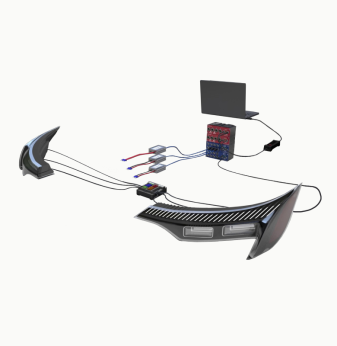Real-Time OS Trends in 2025: What OEMs Should Know Before Choosing

Getting Started: Why RTOS Still Matters
In 2025, real-time operating systems (RTOS) remain at the heart of many embedded systems — from automotive ECUs and industrial robots to consumer IoT devices. With the rising complexity of real-time applications, selecting the right RTOS is more strategic than ever.
This guide explores the latest RTOS trends and outlines what OEMs must consider when choosing a platform for their next-generation products.
Trend #1: Open-Source RTOS Adoption is Accelerating
Popular platforms like Zephyr, FreeRTOS, and RIOT OS are seeing broader adoption due to their transparency, community support, and cost-efficiency.
Why it matters:
- Reduced licensing costs for startups and SMEs
- Faster updates and community-driven patching
- Greater transparency for safety-critical applications
OEM Tip: Verify the project’s governance and long-term maintenance roadmap before committing.
Trend #2: RTOS Platforms Are Becoming More Modular
Vendors are transitioning to component-based architectures where developers can pick only what they need (e.g., kernel, networking stack, security layer).
Benefits:
- Smaller footprint for constrained MCUs
- Lower power consumption
- Easier certification for safety-critical subsystems
OEM Tip: Favor RTOS platforms that support configurable builds and pre-certified safety profiles (e.g., ISO 26262, IEC 61508).
Trend #3: Security is Built In — Not Bolted On
With the rise in firmware-level attacks, RTOS vendors are embedding robust security frameworks directly into the OS kernel.
In 2025, look for:
- Secure boot and chain-of-trust support
- Hardware abstraction for crypto engines
- Isolation between application threads and drivers
OEM Tip: Choose RTOS that support security certifications like PSA Certified, FIPS 140-3, or SESIP.
Trend #4: RTOS + AI/ML Integration is Going Mainstream
OEMs are increasingly deploying machine learning at the edge using real-time operating systems with onboard AI acceleration.
Emerging capabilities:
- RTOS-compatible AI frameworks (e.g., TensorFlow Lite for MCUs)
- Real-time inferencing on low-power SoCs
- Event-triggered ML pipelines
OEM Tip: Validate your RTOS’s compatibility with MCU/SoC-based AI libraries and sensor fusion frameworks.
Trend #5: Certification-Ready RTOS Platforms Gain Popularity
In regulated industries like automotive, aerospace, and medical devices, OEMs need RTOS that simplify compliance with functional safety and cybersecurity standards.
Top choices in 2025:
- QNX (BlackBerry) — widely used in automotive
- SafeRTOS (WITTENSTEIN) — certified for safety-critical systems
- Zephyr RTOS — with increasing momentum in industrial automation
OEM Tip: Confirm toolchain traceability and documentation support for audits.
| RTOS Platform | Modularity | Security Features | AI/ML Readiness | Certifiable Profiles | Ideal Use Cases |
| Zephyr | ★★★★☆ | Secure boot, MPU | Yes | Partial (ASIL B-ready) | Industrial, smart home |
| FreeRTOS | ★★★☆☆ | TLS, secure stack | Basic support | None (add-ons exist) | Consumer, basic embedded apps |
| QNX | ★★★★★ | High (FIPS, MMU) | Limited | Yes (ISO 26262, etc.) | Automotive, medical |
| SafeRTOS | ★★★☆☆ | Certified isolation | No | Full (IEC 61508, etc.) | Avionics, medical |
| ThreadX (Azure RTOS) | ★★★★☆ | Integrated crypto APIs | Moderate | Yes (some modules) | IoT, connectivity-heavy devices |
Promwad’s Role in RTOS-Driven Product Development
At Promwad, we support OEMs in selecting and integrating the best RTOS for their application. Our services include:
- RTOS evaluation and benchmarking for your hardware
- Secure boot and OTA infrastructure development
- Functional safety pre-certification support
- BSP (Board Support Package) customization for modular platforms
We work with FreeRTOS, Zephyr, QNX, and custom RTOS builds to meet your technical, regulatory, and go-to-market goals.

Real-World Case Study: Choosing the Right RTOS for a Wearable Medical Device
A European medtech startup approached Promwad with a requirement to build a wearable heart rate and blood oxygen monitor. The product needed:
- Low latency for real-time sensor data capture
- Secure wireless connectivity (BLE)
- Certification under IEC 60601 and ISO 13485
- Power-efficient architecture for multi-day battery life
Promwad’s RTOS Strategy:
- Evaluated Zephyr, FreeRTOS, and SafeRTOS based on power consumption, certification scope, and BLE stack integration
- Selected Zephyr for its modular build, BLE support, and expanding safety documentation
- Developed a custom board support package with secure boot and encrypted OTA updates
- Integrated on-device AI for anomaly detection using TensorFlow Lite for MCUs
Results:
- First prototype delivered in under 12 weeks
- Achieved BLE certification and passed EMC pre-tests
- Device runtime exceeded 72 hours on a single charge
Final Thoughts: Choose RTOS Like You Choose Your Architecture
In 2025, selecting an RTOS is no longer just about scheduling precision — it's about scalability, security, and certification. The right choice will support your roadmap for years to come.
Work with a partner like Promwad to integrate, harden, and future-proof your real-time embedded stack — from prototype to production.
Our Case Studies in Firmware Development





